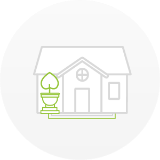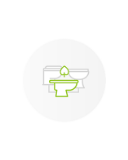Room Ventilation and Extraction Systems Guide
All composting toilets have ventilation systems to aid composting and make toilet use odour-free. These ventilation systems can be electric or passive - they exhaust air from the composting chamber and are a necessary part of air-flow dynamics and code requirements.
It is important to correctly size and spec your composting toilet ventilation system in relation to your other household ventilation systems. Household ventilation systems should not override composting toilet ventilation with counter-flow of air from extractor units, home ventilation systems or heavy natural drafts.
In accordance with the building code, it is standard practice to use one of the following for ventilation of bathrooms/toilet rooms:
- Electric extractor units, often through the wall or inline
- Passive ducted wind-driven ventilation: "turbo" vents or convection currents
- Passive ventilation: window or skylight
- Home ventilation and central heating systems
Below is a breakdown of the above systems and advice on running them without compromising composting toilet ventilation.
Electric extractor
Standard extractor systems are designed to suck air out of a room and blow it outside where it is dispersed. This is counter-intuitive when used in conjunction with a composting toilet as the extraction unit will be fighting against the composting toilet ventilation system flow and may create a back-draft that could leave the room with unwanted odours.
The use of an equalized extraction system is recommended, in which fresh air is pumped in and humid air is pumped out simultaneously. This is done by installing an extraction fan unit in conjunction with an inlet fan unit at the furthermost end of the room by the bathing area (showers, bathtubs, other sources of humidity).
If no equalized extraction system is used, it is possible to run a room extractor unit on its own as long as provisions are made for fresh air to enter the room AND the extraction fan cfm (airflow) is half the cfm of the composting toilet ventilation system. This can be achieved by ordering a fan off WCTNZ® at twice the cfm of your room extractor. Most room extractors on the market move 70cfm.
Passive ducted wind-driven ventilation: "turbo" vents or convection currents
AND
Passive ventilation: window or skylight ventilation
Passive ducted wind-driven room ventilation is good for energy saving, but with heavy winds from the lee-ward side of the building can create a powerful negative pressure in the room and override the composting ventilation system.
The same applies for window and skylight ventilation. Heavy winds can lead to uplift as a result of negative pressure build up from the roofline - this can override the composting ventilation system.
If working on a new build with passive types of ventilation, consider the windward flow and positioning of the toilet and bathrooms.
If there is a window/skylight in the bathroom, avoid compromising composting toilet ventilation by closing the window and allowing the composting toilet to provide ventilation for the room. The composting ventilation system can be part of the design scope for room ventilation. Ventilation required by the code is 25cfm room ventilation minimum per toilet fixture - composting toilet ventilation typically sits around 75cfm.
In case of passive ducted room ventilation or passive ventilation via one of the following: stayed window, cracked skylight or louvred vent; composting toilet ventilation system energy throughput needs to be multiplied proportionate to the potential for back-draft. This can be done by up-sizing the fan to higher wattage and running it in conjunction with a wind-driven vent with optimized spec (see how to achieve this here). This can be done retrospectively if a problem arises.
Home ventilation and central heating systems
Home ventilation and central heating systems vary greatly in their design and can be modified to suit the composting toilet system. Generally, these systems are designed to extract air from the bathroom and toilet rooms, but can be modified by the supplier to blow air into the rooms to create positive pressure which will not affect composting toilet ventilation as long as the pressures and air flows are not too high. In principle, the cfm of composting toilet ventilation should be equal or greater to that of the home ventilation/central heating system. Additionally, these systems can be heated, which is beneficial to composting toilet systems in colder climates.
Ask your home ventilation designer to contact WCTNZ® for system design consultancy.
Need help choosing a system? Call WCTNZ® on 0800 022 027 for free advice on system specification and setup. Advanced design consultancy services are also available.
WCTNZ® | Waterless Composting Toilets NZ Limited | Copyright 2023 ©















